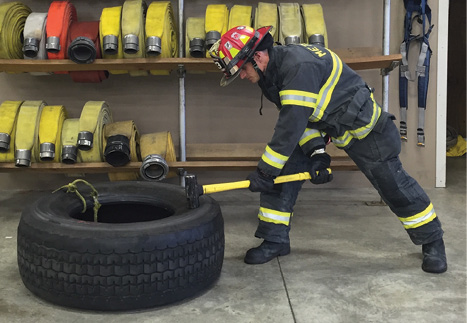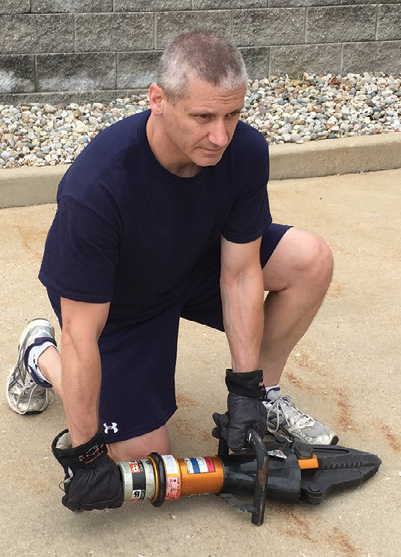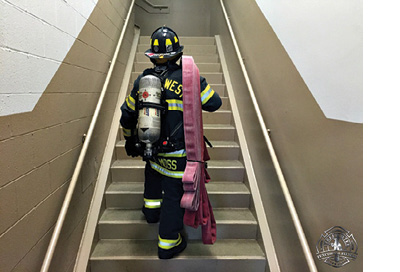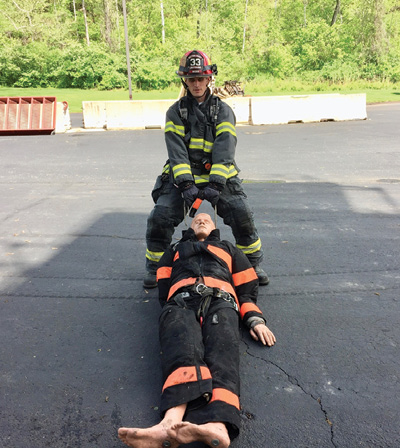

BY DAN KERRIGAN AND JIM MOSS
As firefighters, we have always found a way around obstacles, and our fitness should be no different because it is a job requirement. Any personal attitude that does not accept that we are held to a higher standard will set us up for failure. Remember, we chose this job. We must carry the commitment and perseverance we demonstrated to become a firefighter throughout our careers. Never forget that we set an example to fellow firefighters every day, and inaction is still a decision.
What You Do Matters
When it comes to fitness, we often relate exercises and movements to traditional equipment found at local gyms. Although there are many ways to get a good workout at the gym, not all of us are fortunate enough to have access to the appropriate equipment.
As a firefighter, you must train for the tasks that you are expected to accomplish and for the environments you will encounter. It is for this reason that “keeping it functional” is important, and you can accomplish this more easily than you may think.
How do you train functionally when no traditional equipment is available? We will share eight functional exercises related directly to fireground tasks you can do at your fire station. You can perform them without any special exercise equipment. All you need is your body and some equipment commonly found on your fire apparatus.
Core: Plank Variations
First and foremost, firefighters must develop a strong core. When we think of our core, the exercises that we perform should improve our entire torso (front, back, and sides). A strong core is essential in providing the stability you need to perform strenuous tasks in awkward body positions. It also helps to reduce the chances of back injury—a leading cause of injury and early retirement in the fire service.
Plank variations remain one of our favorite core exercises. They are tremendous exercises to improve core strength, and they can also be combined easily with other movements to help you improve other functional strength components.
• Assume the standard push-up position with your arms straight and your hands directly below your shoulders.
• Maintain a straight line from your head to your ankles, not letting your hips sag, sway, or move upward.
• Use internal tension to “engage” your core and other major muscle groups. Hold for 15- to 60-plus seconds, depending on your current level of core strength.
Progressions include increasing the duration of the plank and varying your stance (e.g., three-point, two-point).
Cardiovascular Capacity: Sledgehammer Tire Strikes
Cardiovascular capacity is essential for strenuous firefighting duties. There are countless ways to improve your cardiovascular capacity without the need for special equipment. Tire strikes are a highly effective means to not only improve explosive cardiovascular capacity but also build your muscular endurance. If you do not have a tire, you can also strike a block of wood or out-of-service large-diameter supply hose (accordion fold). Vary your workout by alternating between overhead strikes, side strikes, and kneeling strikes to simulate forcible entry and manual ventilation positions (photo 1).

(1) Photo by Dan Kerrigan.
Flexibility: Functional Yoga
As firefighters, your most common injury sites typically include the knees, the hips, the back, and the shoulders. Improving your flexibility can go a long way toward reducing your risk of injury. Participating in a 30-minute functional yoga routine once a week is a great way to get the job done. (For two firefighter yoga columns, visit FireEngineering.com’s Fire Life at http://firelife.com/.)
Push: Push-Ups
When you do push-ups, you are moving around 65 percent of your own body weight, which makes push-ups a great exercise that you can do anywhere. Just like planks, there are countless push-up variations you can try to keep it fresh. Challenge yourself with close-grip push-ups; wide-grip push-ups; elevate your feet; try them on kettlebell handles or a BOSU ball; or slow your tempo by counting to five on the descent, holding for five seconds, and pushing your body upward for five seconds.
Pull: Ceiling Hook Simulations
As firefighters, working with our arms overhead in cumbersome turnout gear is a fact of life, and one of the most common tasks is pulling ceilings. You can improve your pull capacity by simply passing a utility rope over a high railing, tying one end of the rope to a heavy object like a foam pail and the other to a ceiling hook, and executing “ceiling pulls.” Complete at least 10 reps on each side of your body for a total of three to five rounds.
Lift: Heavy Equipment Lifts
Firefighters lift heavy objects a lot. The lack of gym equipment is no excuse for avoiding this essential movement in your workout routines. Replace barbells, dumbbells, and kettlebells with equipment found on your rigs such as hose, heavy extrication equipment, power saws, foam buckets, positive pressure ventilation fans, ground ladders, bags of sand, and so forth.
Lift objects like a suitcase (at one or both sides of your body), lift objects that originate between your feet, lift objects to your shoulders, lift them to your chest, or lift them to an overhead position (photo 2).

(2) Photo by Jim Moss.
Carry: Heavy Equipment Carries
Once you lift things, you tend to carry them. Again, there is no need for special gym equipment to improve your carrying capacity. Using the same equipment you chose for your lifting exercises, carry that equipment on level surfaces and up and down flights of stairs. Carrying heavy objects, especially if you carry them on one side of your body or overhead, will also build core strength (photo 3).

(3) Photo by Jim Moss.
Drag: Equipment Drags
One of the most difficult things firefighters may ever have to do is drag a civilian or down firefighter to safety (photo 4). Practicing this potentially life-saving movement is crucial to our fireground performance and can easily be accomplished by tying a rope to any piece of heavy equipment at the firehouse and dragging that object for 50 to 100 feet at a time. Obtain a second-hand wooden shipping pallet or large tire (100 to 300 pounds). Tie on a piece of webbing and start dragging. You can also attach an attack hose and execute hand-over-hand pulls. Drag variations include forward drags, reverse drags, side drags, and crawls with drags.

(4) Photo by Jim Moss.
Fitness Circuit
Instead of doing these exercises in stand-alone fashion, set up five to 10 stations around the firehouse to create a firefighter functional fitness circuit. Position each station so that the walk between them becomes active rest (approximately 25 to 50 feet). Circuits can be performed in gym clothes as well as in various levels of turnout gear; just be sure that your turnout gear is clean and decontaminated.
As you can see, you are limited only by your creativity. When in doubt, grab a tool or piece of equipment off the rig and come up with various ways to work out with it. Push it, pull it, lift it, carry it, and drag it. Physically training with your equipment will not only improve your fitness, but it will also build your fireground skills, muscle memory, competency, and confidence.
DAN KERRIGAN is the chief fire marshal with the East Whiteland (PA) Fire Department and a certified peer fitness trainer. He is the co-author of Firefighter Functional Fitness: The Essential Guide to Optimal Firefighter Performance and Longevity. He has 30-plus years in the fire service and is an advocate for firefighter health and fitness.
JIM MOSS is a career fire officer, certified personal trainer, and published fitness author. He is an advocate of firefighter fitness and wellness on the local and national levels. He trains, writes on, and teaches firefighters how to optimize their physical performance, careers, and lives through firefighter functional fitness.
RELATED
Improving Your Fireground Performance: Firefighter Functional Fitness
Four Fundamentals of Firefighter Functional Fitness
The Three A’s of Firefighter Fitness Success

